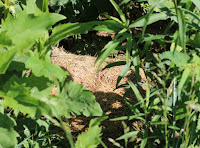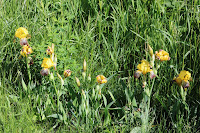I don't usually consider irises as likely candidates to spread out into the wild from their garden beds, but there is at least one other frilly-petaled transplant, this one tall and pale yellow, that had somehow found its way into the Greenway. Perhaps "volunteer" isn't the right word; rather I imagine "chucked into the Greenway with a load of yard waste" as unfortunately often happens. Further south, away from the human habitation, a small stand of a native, Blue Flag Iris (Iris versicolor) was at least in recent years ensconced in the low-lying center of one of the cells, where it is more likely to keep its roots wet.
Upon approaching closer, I saw that, no volunteers, these, the irises were planted in a neat row just at the margin of the mowed area alongside the trail, nestled amongst the grasses in a neat bed of potting soil. An enterprising neighbor, perhaps seeking to beautify the nearby greenspace with some extras from their yard? I was torn.
The flowers are gorgeous, no doubt, and certainly placed there with a good intent to beautify what can seem like a ditch overrun with weedy grass, cattails, and various aggressive non-natives like Queen Anne's Lace and Sweet Clover. What is the harm? That other aforementioned "volunteer" iris has been thus far well-behaved, not spreading or crowding its neighbors. There's no reason to expect these little newcomers to behave differently.
But the threat of introducing non-native species into an uncontrolled landscape looms. After all, there is ample precedent for pretty non-natives turned loose on the landscape and becoming thuggish invasives that crowd out the original inhabitants while offering little to no benefit to the pollinators, birds, and other wildlife that could previously rely on the native plants with which they evolved for millennia. Queen Anne's Lace, Garlic Mustard, Callery Pear, Crown Vetch...all began as pretty garden or useful landscape plants.
Bearded irises don't seem to present the same threat, although there is a non-native Yellow Flag Iris, a beardless "wild iris" that has become quite invasive in neighboring states (it does not appear to be present in great numbers in Iowa yet). So perhaps the new floral neighbors will be well behaved....
 |
| Daisies in the grass |
But what about public, city-owned spaces like the Greenway trail and its flanking stormwater management cells, planted with native prairie plants but also host to a number of non-natives that are considered undesirable, including daisies that look like they escaped a quaint cottage garden, Reed Canary Grass, Wild Parsnip, Multiflora Rose, and the aforementioned Queen Anne's Lace and Sweet Clovers? To those walking the trail, it can sometimes look like a neglected ditch, with a few wildflowers but mostly weeds overtaking the open space. Other parks are carefully tended, with regular prairie burns, attempts to mitigate invasive species like garlic mustard.
 |
| Grass clippings left in the Greenway |
I've been tempted myself to plant some spare Liatris or other native plants I've grown in abundance from seed in the Greenway, to add a bit of diversity. Similarly, informal campaigns by "guerilla gardeners" have attempted to beautify and make use of bits of public or vacant land, and "seed bombs" are a common method of spreading milkweed seeds off the beaten path, wherever the bomb-lobber sees fit.
Are these efforts helpful or harmful? I don't know if I can say.
Clearly I am overthinking these few pretty flowers that have colonized a tiny strip of the Greenway. It's what I do! But it's worth pondering the intent of the Greenway: managing stormwater, providing a place for neighborhood recreation along the trail, and hopefully a bit of habitat for local wildlife. A few well-behaved irises don't interfere with that. Would a few dozen? Would a plethora of neat domestic plants change the character of the wild-and-free Greenway? Does the current plethora of non-natives?
Would the Greenway benefit from a bit more hands-on management, like some of the other more natural parks receive? Or is it a unique and enjoyable insight into what a new paradigm of nature looks like, with plants from all over the world coming together and duking it out until they reach a new equilibrium?
What do we want to see from our Greenway?



